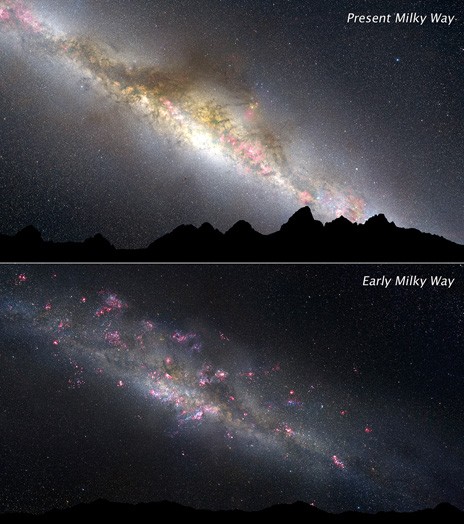Humans take the starry night for granted. But Earth’s night sky hasn’t always sparkled: In the distant past, during the infancy of the Milky Way, it was a much darker place. Now scientists have pictures of what it looked like and how it’s changed.
“For the first time we have images of what the Milky Way looked like in the past,” said Pieter G. van Dokkum, chair of Yale University’s Astronomy department and leader of a project to reconstruct the galaxy’s history with data from NASA’s Hubble Space Telescope. “By looking at hundreds of other distant but similar galaxies, we’ve traced dramatic changes in our own. We’ve captured most of the Milky Way’s evolution.”
Milky Way star formation was explosive in the period between 11 billion and 7 billion years ago, the astronomers found: Nearly 90% of its stars formed then. At peak formation, about 9 billion years ago, it was generating about 15 stars a year, they said.
Today Earth’s twinkling home galaxy forms about one new star per year. In all, it holds about 100 billion stars. (On a clear night, the unaided eye can see several thousand.)
A spiral galaxy that began forming at least 11 billion years ago, the Milky Way is typical in important ways, the researchers say, noting that most stars in the universe live in galaxies like it. While astronomers cannot see actual past incarnations of the Milky Way, Hubble lets them see far distant, fundamentally similar galaxies, representing the Milky Way’s appearance at different moments in time.
A word about seeing into the past: Light takes time to travel. The light from the Sun, for example, takes eight minutes to reach Earth. This means we see the Sun as it was eight minutes ago. The farther away an object is, the longer it takes for its light to reach us. The distant galaxies seen by the Hubble Space Telescope are so far away that their light has traveled for billions of years. So we see these galaxies not as they are now, but as they were long ago.
“It’s like we’re traveling back in time,” said Erica Nelson, a Yale graduate student and a member of the research team. “By studying the Milky Way’s ancestors, we can see what it would have looked like. And as we travel backward we see stars winking out of existence. If you go back far enough, 11 billion years or so, the sky from Earth (if Earth had existed then) would look almost empty.”
Van Dokkum’s team traced the history of Milky Way star formation by studying about 400 galaxies, selected from a sample of more than 100,000 galaxies observed by Hubble covering about 11 billion years of cosmic history. These galaxies are expected to evolve as the Milky Way did.
At first the Milky Way, like other galaxies, had lots of gas but no stars. Gravitational forces compressed the gases to extreme densities, leading to the birth of stars.
By the time Earth formed, 4.5 billion years ago, the Milky Way’s rate of star birth had slowed dramatically, to the rate of about three per year.
“The show was mostly over,” van Dokkum said.
The team relied on three large Hubble galaxy programs: the Great Observatories Origins Deep Survey (GOODS), the Cosmic Assembly Near-infrared Deep Extragalactic Legacy Survey (CANDELS), and the 3D-HST survey.
“A lot of what we accomplished required the excellent vision of the Hubble Space Telescope,” said Joel Leja, a graduate student in astronomy at Yale and member of the research team. “The Hubble images help us see the Milky Way ancestors all the way to their early youth. To get the first baby pictures, we need the infrared eyes of NASA’s James Webb Space Telescope, scheduled to launch in 2018.”
The authors reported their research in a paper in The Astrophysical Journal Letters titled “The Assembly of Milky Way-like Galaxies Since z ˜ 2.5.” A related paper is in press. The papers contain full lists of co-authors.


